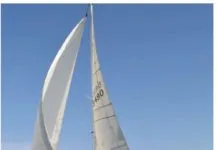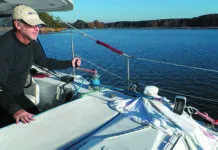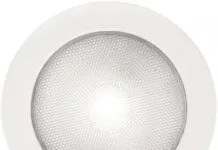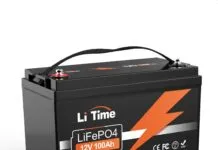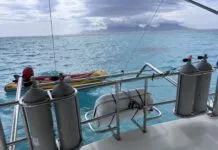The Pitfalls of Eco-nice Antifouling
As much as I enjoy messing around with boats, the job of prepping a hull and applying antifouling paint is one I could live without. A do-it-yourself paint job is not as loathsome as it used to be, but it’s still one of my least favorite tasks. In recent years, paint makers have begun adding a range of water-based antifouling paints to their lineups. These new paints eliminate most or all of the strong solvents that make painting unpleasant and that, over time, can be harmful to our health and the environment.
The Problem with Stainless Steel
One of the biggest hits to a boater’s wallet is the high price of 316 stainless-steel hardware. But trying to sort the good from the bad in a bin full of mystery-grade stainless-steel screws and bolts is like rolling dice.
More Marine Treasures To Buy Used
As the economy has withered, the market for secondhand boat gear has flourished. Used marine-gear stores such as Fort Lauderdale’s Sailorman and Newport Beach’s Minney’s have seen both the supply and demand of used boat gear on the rise. Buying secondhand is typically easier on your wallet and on the environment, but used gear shopping certainly has its ups and downs. In this report, Practical Sailor talks to those in the know—the friendly faces running the secondhand marine stores—and takes a look at what used gear to look for and what to steer clear of. Deck gear—snatch blocks, winches, bronze cleats—can be worth the bin-digging at a boating consignment shop. Ground tackle, if it has a shank stamped with a recognizable brand name, also can be a smart buy. However, purchasing used marine electronics, safety gear, or an anonymous anchor can be iffy. As with any gear purchased secondhand, it's buyer beware. Sailors should do their research before heading to a consignment store, and always take with you a list and a budget.
A Treasure Hunting Guide to Secondhand Boat Gear
As the economy has withered, the market for secondhand boat gear has flourished. Used marine-gear stores such as Fort Lauderdales Sailorman and Newport Beachs Minneys have seen both the supply and demand of used boat gear on the rise. Buying secondhand is typically easier on your wallet and on the environment, but used gear shopping certainly has its ups and downs. In this report, Practical Sailor talks to those in the know-the friendly faces running the secondhand marine stores-and takes a look at what used gear to look for and what to steer clear of. Deck gear-snatch blocks, winches, bronze cleats-can be worth the bin-digging at a boating consignment shop. Ground tackle, if it has a shank stamped with a recognizable brand name, also can be a smart buy. However, purchasing used marine electronics, safety gear, or an anonymous anchor can be iffy. As with any gear purchased secondhand, it's buyer beware. Sailors should do their research before heading to a consignment store, and always take with you a list and a budget.
Hobie Mirage: Paddle, Pedal, Power, or Sail
The Hobie Mirage Tandem Island, a mouthful we’ll refer to as the HMTI, is the latest incarnation of Hobie’s capable and creative engineering team. This triple-play trimaran can be paddled, pedaled, and sailed using dozens of Hobie’s in-house designed parts. A specialized Torqeedo electric outboard (www.torqeedo.com), which can be dropped into a drive slot, adds a forth dimension to this multi-tasking multihull.
Sailboat Design Conference Part I
Beyond the text and photos contained in a sailboat manufacturing company’s brochures, and the words of a dealer or salesperson, and absent an understanding of yacht design, discerning the actual capabilities of today’s production boats is a major task. Gone are the days of Herreschoff et. al., when the conventional wisdom held that a long, deep keel was the best method of producing good tracking, displacement produced a seakindly ride, and performance (straightforward speed) was a simple matter of adding sail area. Prior to the age of fiberglass, most yachts used similar raw materials (wood and metal), and construction methods, so those variables were not generally a consideration.
Sailboat Design Conference Part II
Take a cursory glance at a new 35-footer and you might easily conclude that, except for cosmetic changes, the boat is essentially unchanged from those that made their debut in 1995. But that is not the case. In contemporary designs, modifications to deck layouts, the design of creature comforts, and boathandling systems, all reflect the market's desire for easy use, as evinced by below-deck sheeting systems (X Yachts), electrically controlled stern platforms (C&C), and removable traveler systems (Etap), for instance.
In-Boom Furling: Five Systems
There's no perfect solution to boom furling. It's not an easy bit of engineering. Still, all the systems on the market continue to mature. Schaefer's new offering looks like a good bet for medium-sized boats.
Mainsail Track Hardware
The systems used to attach a mainsail to its mast have come a long way since the time of hoops and parrels, and the variety of options now available for retrofitting plays to the advantage of the consumer.
Do You Want a Headsail Luff-groove Device?
Unless the boat was equipped with two headstays, which adds considerable windage, the headsail change drill meant releasing the lowest hanks on the headsail in use, tacking down the new sail, hanking it on below the head-sail already up, taking a deep breath, letting the jib halyard run, then going like mad to get the hanks open on the old jib, all the time listening to the skipper scream to hurry up.


